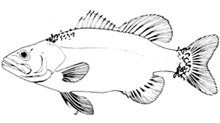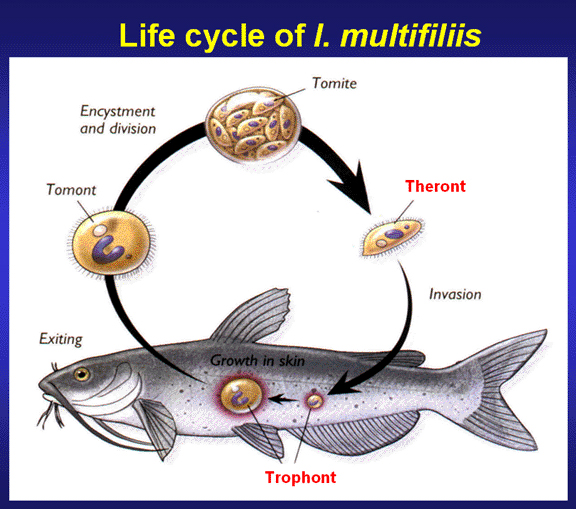Protozoan diseases

Protozoan diseases
These are microscopic, single-cell animals. They can be found on the gills, body surface or imbedded in the flesh. There are many different protozoans, and they cause a variety of fish diseases. Protozoan diseases are among the most significant of all parasitic diseases in fish farming. Following are the most important parasitic protozoans parasitizing fish species.
Ichthyophthirius
"Ich" or white spot disease is probably one of the most detrimental parasites. The causative agent is Ichthyophthiriasis multifilis.The most common symptom is the presence of pin-head size white spots on the skin, fins and gills. It causes simple hyperplasia of the epidermal cells around the site of infection forming blisters. Ich is a ciliate characterized by its relatively large size and horse shoe-shaped nucleus in adults and large trophozoites. Incidence of large scale mortalities due to the infection is common in nursery and rearing ponds.
Trichodina:
Trichodina is another small saucer-shaped protozoan that harbour gills and external body surface. It is identified by ‘denticular ring’ of interlocking teeth and peripheral band of cilia. Excess mucus secretion is a common symptom of this infection. Epizootics are usually associated with poor water quality and high stocking density in fry and fingerling rearing ponds.

Costia:
A mastigophoran parasite Costia causing considerable damage is also observed in freshwater carps. This is a minute pear shaped parasite found attached to the gills or skin and produce a severe imitation with excessive mucus secretion causing patches over the body.
Myxosporidian and Microsporidia spp:
Myxosporidian and Microsporidian parasitic infections are very frequent in major carp species. Reports of large scale mortalities of fry and fingerlings of carp species are common due to such infections. Several species of Myxosporidia have been found to infect all the carp species and form cysts on the body surface, fins, gills and internal organs like kidney and spleen. However, the damage is more when large numbers of cysts are present on the gills and the breathing of the fish is adversely affected. Renal infections lead to the damage of most of the renal tubules in the form of vacuolar degeneration of the tubular epithelial cells. In most cases the nuclei of the infected epithelial cells become pycknetic. Microsporidian infections are most common in catla among Indian major carps. The parasite harbours the intracellular spaces of the epthelial cells of the renal tubules. The most common symptoms of the disease are weakness, emaciation, scale protrusion, loss of scales, abnormal pigmentation etc.
Suggested Products
- Address
- Neospark Drugs and Chemicals Private Limited Corporate Center,
241, B.L. Bagh, Panjagutta,
Hyderabad- 500 082,
Telangana, India.
- Product Groups
- Poultry
- Large Animal
- Aquaculture
- Feed
© 2025 Neospark Drugs and Chemicals Private Limited